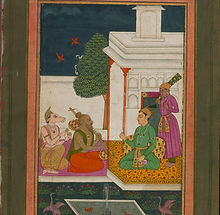Jod
Jod in Hindi conveys the meaning of 'connection' or also 'through which things are connected.' It serves as the part that links the arrhythmic phase of the Ālāpa with the Tāra-Ālāpa, the rhythmic part, which also incorporates the Jhālā.For the Joḍ to effectively fulfill its role of conjunction, it needs to be expressed in a subtle manner so as not to introduce any detachment or discordance within the overall performance. Hence, only a slight rhythmic hint is transmitted during this transition phase.Madh or Madhya - this phase maintains a medium-speed tempo where rhythmic hints first appear. This moment is further divided into three sub-categories:1. Madhya-Vīlambita
2. Madhya-Madhya
3. Madhya-DrutaThese are relative terms without specific time measurements, as the tempo depends on the musician and audience. However, it is essential to consider that some instruments allow for a more sustained performance than others.Madhya-Vīlambita: Musicians refer to this phase as 'Ḍagar kī Baḍhat,' where Ḍa, Ga, and Ra strokes on the Vīṇā increase in speed. Factors like Cikārī, Mīḍ, and Syuṁt (Āśa) become more frequent compared to the previous Vīlambita. Selective use of the sixty-three Alaṁkāras is incorporated.Madhya-Madhya: Musicians term this phase 'Madh Joḍ' or sometimes 'Barābar Kī Joḍ.' 'Barābar' in Hindi takes on the meaning of 'flowing' or 'well-suited.' Gamaka-Joḍ is used during this phase, and Mīḍ and Syuṁt (Āśa) decrease, with notes expressed independently. Cikārī is used to a minimum, and the appearance may resemble the Khaṇḍāra Vāṅī, introducing the Viḍāra composition style.Madhya-Druta: Some musicians refer to it as 'Laḍī-Joḍ.' It remains similar to Madhya-Madhya but slightly faster, with a further decrease in the use of Cikārī.Druta: This phase is marked by a higher-speed tempo and the total absence of Cikārī. It is also divided into three sub-categories:
1. Druta -Vīlambita
2. Druta -Madhya
3. Druta -DrutaDetails about these subdivisions are not necessary, with reference to the previous ones sufficing.
INDIAN CLASSICAL MUSIC LESSONS AND ONLINE COURSES
IN MODAL MUSIC, IMPROVISATION AND COMPOSITION
LEARN THE MAIN TECHNIQUES OF INDIAN MUSIC WITH A SIMPLE AND PERSONALIZED METHOD!
My online music lessons are the perfect way to learn to sing, or improve the vocal techniques already acquired, or to start playing your favorite instrument or progress in your musical path through an alternative teaching method to Western teaching.
The goal of my Indian classical music courses is to teach you the basics of this wonderful art form. You will learn about the various Ragas, or modal scales, the Talas or rhythmic cycles, and the vocal and instrumental techniques used for improvisation in Indian classical music.
What makes my approach to teaching indian classical music so distinctive?
My teaching system is obviously unique and different from others and I think that learning music following the traditional Indian approach is the most effective method regardless of genre: pop, jazz, world fusion, electronic, whatever musical style you if you are interested, I guarantee that thanks to the Indian perspective, you will have an edge over all the other musicians.
What will you learn?
During my lessons I use a variety of techniques and exercises to learn to improvise and compose. What you will learn in my Indian classical music courses will be based on the concepts of modal scale and rhythmic cycle, i.e. Raga and Tala. You will also learn vocal and instrumental techniques which, although based on Indian musical theory, also find application in the Western musical system.
Will the course suit you?
My courses are aimed to all musicians of all levels, beginners, intermediate and advanced, offering different study materials and techniques from the usual Western standards. All those who want to learn to play Indian classical music are welcome and no previous knowledge or experience is necessary to get started.
I can not wait to get to know you!
Contact me now! The first lesson is FREE!











%2018th-19th%20centuries%20b.jpg)




